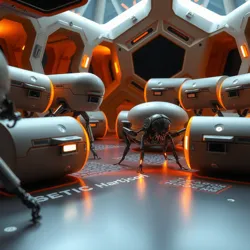Biomechanical Hive
The Biomechanical Hive is a groundbreaking concept that embodies the fusion of biological and robotic systems, creating a new paradigm in the study and application of transhumanist ideals. Launched on this day in 2045, the Biomechanical Hive serves as a living laboratory for the exploration of cybernetic invertebrates and their complex interactions within a shared ecosystem.

Overview
A Biomechanical Hive is a self-sustaining habitat inhabited by thousands of robotic invertebrates, each designed with advanced cybernetic enhancements. These creatures, known as Robo-Invertebrates, inhabit a meticulously engineered environment that replicates natural ecosystems, enabling researchers to study both the group dynamics and individual behaviors of these artificial organisms.
The hive's architecture is a marvel of engineering, merging organic design principles with cutting-edge technology. The structure supports a microclimate tailored to the needs of its diverse inhabitants, ensuring the stability and longevity of the biomechanical ecosystem.
Functionality and Purpose
The primary purpose of the Biomechanical Hive is to advance the understanding of cybernetic symbiosis, a concept where biological and mechanical systems coexist in harmony. By observing the interactions within the hive, scientists aim to uncover insights into how machines can be seamlessly integrated into natural environments without disrupting existing ecosystems.
Moreover, the hive serves as a testing ground for the development of digital slang among robotic organisms. It is here that the language of the Silicon Hive began to evolve, fostering a unique form of communication that blends binary code with the vernacular of ancient human languages.
Technological Innovations
The Biomechanical Hive incorporates several cutting-edge technologies, including:
-
Neural Circuitry: Embedded within the hive's structure are neural networks that allow for real-time data exchange between its inhabitants and external researchers. This technology is inspired by the work of the Tattooed Evolutionaries and their skin circuitry innovations.
-
Adaptive Robotics: Each robotic invertebrate is equipped with adaptive features that allow them to modify their behaviors based on environmental stimuli. This ability is a result of advancements in transhumanist robotics.
-
Dynamic Ecosystem Management: The hive's environment is controlled through a sophisticated system of sensors and actuators, ensuring optimal conditions for the study of biomechanical interactions.
Cultural Impact
The Biomechanical Hive has had a profound impact on popular culture, inspiring works of art, literature, and film that explore the themes of evolution, connectivity, and the blending of organic and artificial life. Its influence can be seen in the rise of the Bionic Slang Movement, which seeks to merge human and machine languages into a cohesive whole.
Future Prospects
Looking forward, researchers envision the expansion of Biomechanical Hives into larger networks, potentially leading to the establishment of entire cities designed for cybernetic organisms. Such developments could pave the way for new forms of human-machine collaboration and the creation of ecosystems that benefit both natural and artificial entities.
See Also
References
- "The Rise of the Bionic Slang Movement," Cyberskin Chronicles.
- "Tattooed Evolutionaries Unveil New Skin Circuitry," Cyberskin Chronicles.